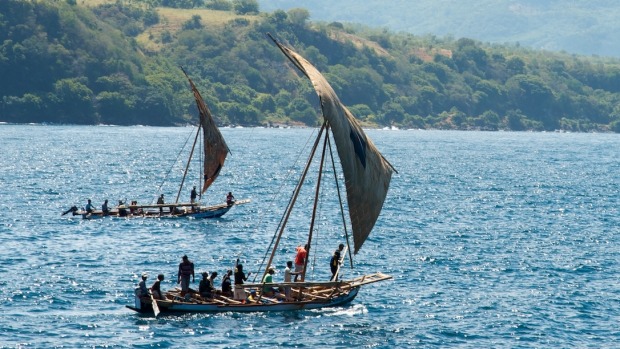
The main path from the beach to the heart of the village is lined with semi-dried strips of blubbery meat draped on simple wooden frames. Colourful fabric triangles flap in the sea breeze from the top of stripped branches staked into hefty sun-whitened vertebrae.
The lane runs between two of the many open-air boathouses that collectively extend the full width of the beach and house narrow wooden vessels all pointed seawards, as though ready to go at any time, which they are. This is Lamalera, one of Indonesia's last two whaling villages.
The Savu Sea has quite a roll to it the day we visit and enough swell that many of the local men volunteer to help our expedition crew land each inflatable boat safely onto the sand. These Lamaleran whalers have done this countless times with their own boats in much rougher conditions for more generations than anyone knows. The first European record of their existence is an anonymous Portuguese document from 1643, when a completely different type of vessel from our small cruise ship would have been perched on their horizon.
We gather on the pathway for a formal welcome, where palm wine, tobacco and scarves are presented to our representatives. Most of the hundred or so passengers I'm travelling the Malay Archipelago with have come to shore, curious about this 2500-person village on the south coast of Lembata Island in the Lesser Sunda Islands of eastern Indonesia. Two weeks into the trip, meeting new people and experiencing new places have become our way of life.
"Each part of the whale has an owner," Lamalera's spokesperson explains, once we're seated in the shade of a huge tree in the middle of the village. "Almost all parts of the whale are distributed to members of the tribes." She is referring specifically to the sperm whale, central to the culture of this society, in which a great deal of lore is attached to its demise and distribution. The people also catch fish, dolphins and whale sharks, but, apart from orca, it is taboo for them to hunt or kill any other type of whale than sperm whales.
Despite heavy missionary influence, the Japanese occupation of Lembata during World War II and a well-established Catholic education system, traditional whaling has survived here. Although some Lamalerans have become professors, doctors, journalists and government officials, many families live subsistence lifestyles, with very little exchange of currency. They trade their harvests from the sea for vegetables, corn and rice from the next village.
After a group of women perform dances that portray various aspects of village life, we're invited to join them in a circle for simpler steps. Samples of local food are passed around and we then have the afternoon to wander, socialise and watch demonstrations of rope production, made from scratch using local vegetation, and the forging of harpoon heads. Older women sell their wares in the square or along the main street, particularly ikat scarves that are handwoven with tie-dyed thread. Local children strike harpooning stances for our cameras.
Lamalera fights to maintain its traditional way of life. It's alleged the village takes 15 to 20 sperm whales each year from the Savu Sea, pursues only those initially visible from shore, and not a scrap is wasted. Using few instruments of modern technology, the people of Lamalera and Lamakera, on the nearby island of Solor, still practise what these days is referred to as sustainable hunting, now that humans have achieved the alternative.
After our inflatable boats have been pushed back out to sea, some of Lamalera's fleet also launch to give us a show. With boats under sail, each harpooner leaps into the sea, throwing their full body weight behind a single powerful thrust of the long bamboo spear at imaginary prey.
From the bow of our own vessel, it's like looking through a portal into the past to a time when it was a fairer fight between human and beast and when people truly put their lives on the line to source meat from its natural habitat, although I wonder whether passengers would still clap and wave if this suddenly turned real.
MORE INFORMATION
aptouring.com.au
CRUISING THERE
APT sails many of the world's seas and rivers. The company owns and operates three small ships – MS Caledonian Sky, MS Island Sky and MS Hebridean Sky – for expedition-style trips in Asia, Northern Europe and the Kimberley. Fares for the Seven Seas Odyssey, which will be called 17-day South East Asia Adventure in 2016, are from $11,995 a person, twin share. The price includes shore excursions, all meals, all beverages (apart from premium wines and spirits), gratuities, port charges and transfers. This style of cruise is not equipped to accommodate passengers in wheelchairs. Phone 1300 196 420. See aptouring.com.au.
The writer travelled courtesy of APT.